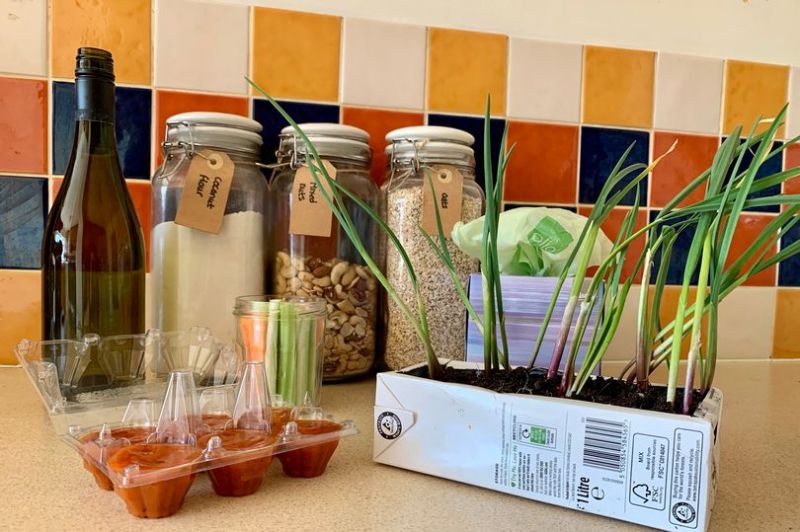The latest on all kinds of information, news, and resources that help you make working remotely better.
5 Productive Things You Can Do While In Quarantine | Blair Flood, Money.com

If you’re among the thousands of Americans who suddenly find themselves with extra time in their day due to new work from home policies (less commute time) or temporary leave, we came up with these 5 productive things you can do while in quarantine to help you keep your sanity.
1. Learn about the stock market to be prepared
Market sell-offs create huge buying opportunities. A Motley Fool Stock Advisor membership provides you with the market research you need to navigate these difficult times.
Once you figure out what to buy, you’ll need to figure out how to buy. In just a few years, Robinhood has become one of the largest stock trading apps in the country, offering commission-free trading and an easy way to start investing. They offer you the ability to start with as little as $1 and buy fractional shares, so if your favorite company’s stock is a little too expensive, you can still get involved.
2. Make sure your credit report is in good shape
Don’t make the same mistake! There are sites that allow you to see a free copy of your credit report and services that help you monitor your credit in real-time. This will allow you to catch any errors before you go to apply for a loan or credit card. Spending a few minutes now to make sure that your credit report is in good shape could save you a ton of time down the road.
3. Keep your mind busy by learning a new language
Learning a new language has been on my to-do list for years, and I’m finally checking it off. I want to be fully prepared once it’s safe to travel again, and to be honest, it’s not taking nearly as much time as I thought.
4. Use this time to compare prices on your home and car insurance
If you don’t own a home, but are still looking to save some money, getting an updated car insurance quotes is a great way to find savings. MONEY’s recent article The Best Auto Insurance for 2020 is a great place to find a few companies to get quotes from. Even if you don’t end up switching, it’s a good idea to see what you can save.
5. File your taxes
If you’re sheltered in place, tax preparation software is the way to go. Most companies offer free online software, but charge extra for assistance. I learned the hard way that paying the extra fee can be worth it if you have a complicated filing (like getting a letter from your city saying that you owe them taxes from over 4 years ago… You can always add on the assistance later if you need it, so start with the free version and see how far you get.
Now, Relax!
You’ve earned it. Call that friend you’ve been wanting to video chat with for a while, relax with a glass of wine delivered to your door, read that book that you started over Christmas break and never finished, or spend time making a home-cooked meal.
How to maintain employee performance during COVID-19 | HRD, Hcamag.com

The majority of organisations have focused on scenario planning and necessary operational responses to ensure business continuity during COVID-19, according to Brian Kropp, chief of research for the Gartner HR practice.
However, these plans often do not address, nor impact, employees’ ability to focus on their work, Kropp added.
According to Gartner, HR should help managers at all levels do six specific activities to ensure employees get the requisite support to tackle the emotional response:
Sense employees’ need for support
Managers need to recognize signs of distress among their people, both directly through conversations and indirectly through observation.
To facilitate regular conversations between managers and employees, HR should provide managers with guidance on how best to broach sensitive subjects arising from the COVID-19 pandemic, including alternative work models, job security and prospects, impact to staffing, and tension in the workplace.
Promote dialogue to build understanding
Two-way communication with managers and peers provides employees with the information and perspective they need, while allowing them to express and process negative emotions and improve their feelings of control.
HR leaders should help managers create opportunities for two-way dialogues that focus on a realistic picture of both the positive and negative implications of the current COVID-19 outbreak.
Use objectives to create clarity
Clear objectives and regular updates on possible changes will help ensure employees maintain focus, energy and a sense of purpose.
HR leaders can help managers reassert the link between employees’ work and organisational success by providing visibility into the current organisational goals and translating the organisation’s vision into their employees’ context.
Reinforce organisational values to reduce the like hood of misconduct
Apart from modeling the right behaviors, managers should encourage whistleblowers to call out unethical behaviors, remind staff of the channels for reporting misconduct, and highlight punitive measures for noncompliance.
Tailor recognition to acknowledge employee efforts
Recognition can take many forms other than monetary rewards — public acknowledgment, tokens of appreciation, development opportunities and low-cost perks.
For organisations facing a slowdown in business, managers can take this opportunity to provide development opportunities to employees who normally do not have capacity. This reinforces the organisation’s commitment to the long-term success of the employee.
Drive engagement via innovation
While managers and employees may understandably become more risk-averse in this uncertain environment, it is these times of change and disruption that innovation and risk-taking become even more important for employee engagement and organisational success.
The disengaging effect of constraints on innovation and risk-taking are particularly severe for high-potential (HIPO) employees who tend to have a stronger desire for these types of opportunities.

With the nation on lockdown, if you get bored at home these tricks will certainly inspire you.
1. Tissue box
Fill an empty tissue box with carrier bags, bin bags or food waste bags and pull them out as you would a tissue.
2. Egg cartons
Don’t waste that last drop of sauce. Instead pour it into plastic egg cartons to make single serve portions.
3. Freeze milk
There are lots of foods that can be frozen which you might not realise, including milk.Frozen milk should be thawed before it is used and be sure to give it a big shake before you pour it to ensure all the solids and liquids have been fully mixed.
4. Microwave bread
You can make bread in the microwave, yes really. Plus it takes just 90 seconds to cook. For the full recipe click here.
5. Pasta recipe
Did you know you can make pasta from scratch with just four ingredients and it takes under 10 minutes to make? Watch this video here showing how to make it in a flash.
6. Jam jars
Clean, empty jam jars can be used for a whole host of things including tea light holders, mini vases for wild flowers and, our favourite, for keeping food in.
7. Hang cleaning products on a rod
If the cupboard under your sink is a mess and you can never find that bottle of kitchen cleaner, make a rail for them. Screw a metal rod into the cupboard and hang the handles on it to make more space.
8. Saucepan handles
If you didn’t know, the reason why there is a hole in a saucepan handle is so that you can rest a wooden spoon in it.
9. Put paper towels in the salad drawer
Kitchen roll absorbs the condensation that vegetables generate as they chill. So put a layer of paper in the fridge draw to keep them fresher for longer.
10. Wine bottle watering can
Use your empty wine bottles as watering cans to feed the plants. Alternatively, they make a fancy water carafe for the kitchen table.
11. Coffee jar vase
Bigger than a jam jar, they make excellent vases.
12. Planter box milk cartons
Simply cut them in half, fill with soil, pop in seeds and watch your flowers or herbs grow. It’s great fun for kids and they can decorate the boxes too.
13. Banana pancakes
If you can’t get hold of flour, eggs or milk, you can still enjoy pancakes with this healthier alternative. Just mash one banana, blitz an handful of oats into a flour consistency, mix them together and then fry in a pan.
14. Nice cream
Nice cream as opposed to ice cream because it’s nice and healthy. It’s virtually fat free and has no refined sugars. All you need to do is cut a ripe or over ripe banana into chunks and freeze. Once frozen remove and blend it with a splash of milk to a thick and creamy texture. You can customise it however you like. We like blitzing frozen strawberries with it too for yummy strawberry and banana nice cream.
15. Flip your cereal bag before opening
Hate finding crumbs at the bottom of your cereal packet? Don’t throw them away or suffer with a mushy breakfast. Just shake the bag each morning to distribute all those little bits.
6 productivity tips for staying on schedule when working from home | Hope Reese, Techrepublic.com

Working from home can also bring distractions from friends, family, social media, new obligations at home––especially if you’re sharing space with others––and reinventing schedules. All these things are likely to throw you off your routine. As a result, it’s easier to lose track of time or miss out on the regular reminders about important workplace meetings.
Here are six tips from productivity experts about how to stay on schedule and not miss out on important workplace meetings:
1. Create a new alert infrastracture
Gretchen Rubin is the author of the international bestseller The Happiness Project. As someone who has dedicated a lot of thought to examining the best way to live a productive and fulfilling life, you could call her an expert on setting healthy habits.
“I’m losing my sense of time,” Rubin told TechRepublic. “I usually know exactly what time it is, and what time of day it is, and it’s getting lost. So, even if you don’t usually depend on calendar alerts and putting Post-it notes up, you might find you need to build up more infrastructure.”
2. Make it clear to others that you are home, but you are still working
If you have roommates, a partner, or kids at home, working at home might make it seem as though you’re more available for activities around the house or hanging out. And while the great benefit of working from home is the increased flexibility, it’s critical to make sure you maintain a healthy boundary between your home life and your work life.
Gently inform others who might be distracting you from your work schedule that you need to stick to your schedule. If it’s you who is creating the distractions, make sure that you keep yourself accountable by setting hours and sticking to them. Close the door to your office area, if possible, or put in headphones to block outside sounds.
3. Stop messing around on Instagram
To counteract your social networks’ ease of use during work hours, remove them from your browser shortcuts and, according to Fast Company, log out of every account. You might even consider working primarily in a private or incognito browser window. This ensures you stay signed out of all your accounts and each web search you conduct doesn’t autocomplete the word you’re typing. It’s a guarantee that you won’t be tempted into taking too many social breaks during the day.
4. Write down your schedule – and stick to it
Rubin suggests writing things down on paper to stay on track. “Without the infrastructure and the social aspects of seeing people come and go, you might forget. You might have to prepare something for Friday, but you feel like Friday is an eternity away,” she said. “Yet time is still passing, so you might need to write things down more explicitly.”
5. Create your own workspace
It’s key to make a space that feels like it’s meant to get work done. That means avoiding your bed and sofa, if possible. “I think a lot of people would benefit from reimagining their space,” Rubin says. “You might even need to move your childrens’ bedrooms around to make a work or study space.”
6. Double-check your tech
Many of us have experienced the dreaded moment when your conference call has started, but you’re not able to get into it. Maybe your internet connection is slow. Maybe you haven’t downloaded the proper software. Maybe you haven’t checked your audio. For those working at home in the age of COVID-19, the problems could be amplified––maybe other people in your space are loud, and you can’t hear the meeting. Or you’re juggling multiple meetings online and finding it hard to keep track which one you’re supposed to join.